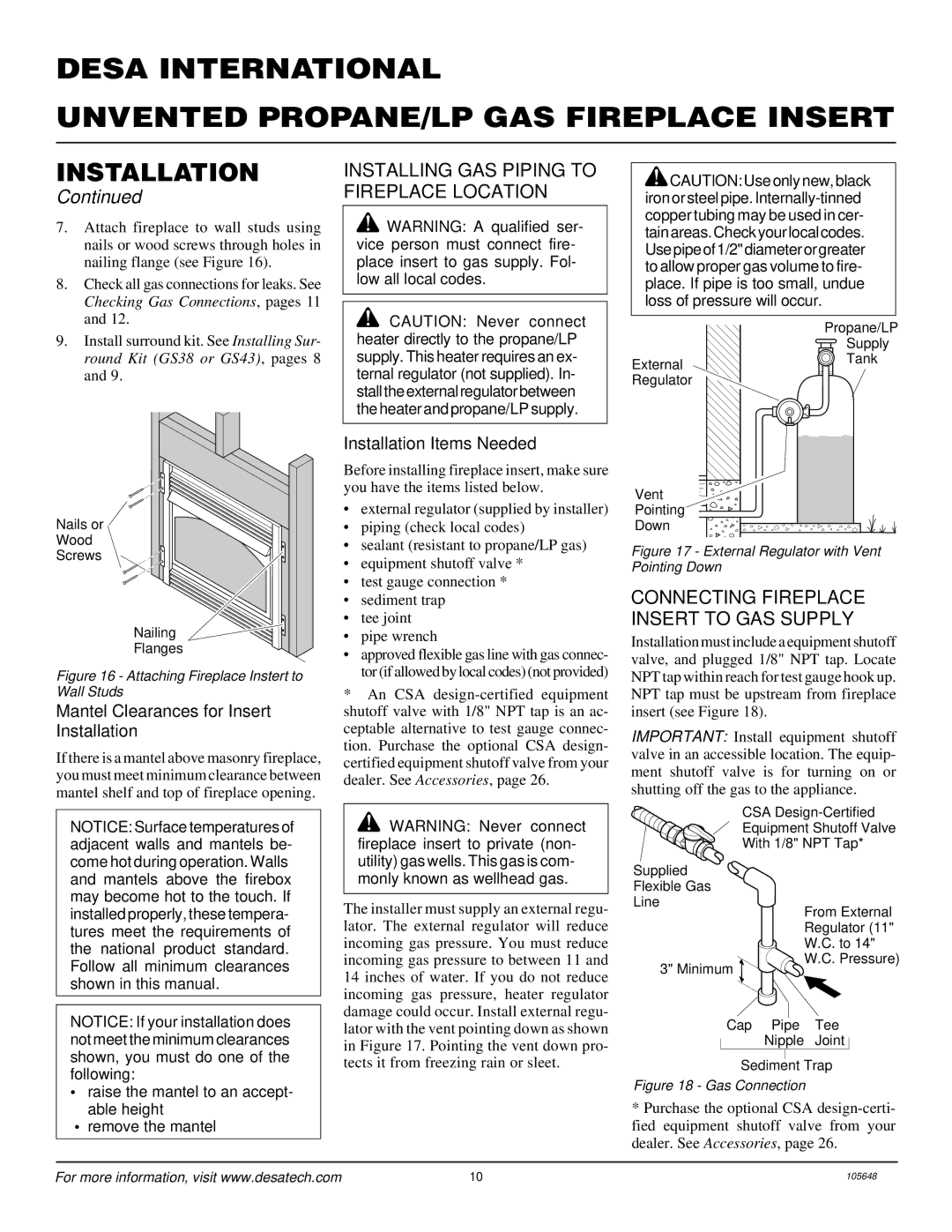
DESA INTERNATIONAL
UNVENTED PROPANE/LP GAS FIREPLACE INSERT
INSTALLATION
Continued
7.Attach fireplace to wall studs using nails or wood screws through holes in nailing flange (see Figure 16).
8.Check all gas connections for leaks. See Checking Gas Connections, pages 11 and 12.
9.Install surround kit. See Installing Sur- round Kit (GS38 or GS43), pages 8 and 9.
Nails or
Wood
Screws
Nailing
Flanges
Figure 16 - Attaching Fireplace Instert to Wall Studs
Mantel Clearances for Insert Installation
If there is a mantel above masonry fireplace, you must meet minimum clearance between mantel shelf and top of fireplace opening.
NOTICE: Surface temperatures of adjacent walls and mantels be- come hot during operation. Walls and mantels above the firebox may become hot to the touch. If installed properly, these tempera- tures meet the requirements of the national product standard. Follow all minimum clearances shown in this manual.
NOTICE: If your installation does not meet the minimum clearances shown, you must do one of the following:
•raise the mantel to an accept- able height
•remove the mantel
INSTALLING GAS PIPING TO FIREPLACE LOCATION
![]() WARNING: A qualified ser- vice person must connect fire- place insert to gas supply. Fol- low all local codes.
WARNING: A qualified ser- vice person must connect fire- place insert to gas supply. Fol- low all local codes.
![]() CAUTION: Never connect heater directly to the propane/LP supply. This heater requires an ex- ternal regulator (not supplied). In- stall the external regulatorbetween the heater and propane/LP supply.
CAUTION: Never connect heater directly to the propane/LP supply. This heater requires an ex- ternal regulator (not supplied). In- stall the external regulatorbetween the heater and propane/LP supply.
Installation Items Needed
Before installing fireplace insert, make sure you have the items listed below.
•external regulator (supplied by installer)
•piping (check local codes)
•sealant (resistant to propane/LP gas)
•equipment shutoff valve *
•test gauge connection *
•sediment trap
•tee joint
•pipe wrench
•approved flexible gas line with gas connec- tor (if allowed by local codes) (not provided)
*An CSA
![]() WARNING: Never connect fireplace insert to private (non- utility) gas wells. This gas is com- monly known as wellhead gas.
WARNING: Never connect fireplace insert to private (non- utility) gas wells. This gas is com- monly known as wellhead gas.
The installer must supply an external regu- lator. The external regulator will reduce incoming gas pressure. You must reduce incoming gas pressure to between 11 and 14 inches of water. If you do not reduce incoming gas pressure, heater regulator damage could occur. Install external regu- lator with the vent pointing down as shown in Figure 17. Pointing the vent down pro- tects it from freezing rain or sleet.
![]() CAUTION: Use only new, black iron or steel pipe.
CAUTION: Use only new, black iron or steel pipe.
Propane/LP
Supply
External![]() Tank
Tank
Regulator
Vent
Pointing
Down
Figure 17 - External Regulator with Vent Pointing Down
CONNECTING FIREPLACE INSERT TO GAS SUPPLY
Installation must include a equipment shutoff valve, and plugged 1/8" NPT tap. Locate NPT tap within reach for test gauge hook up. NPT tap must be upstream from fireplace insert (see Figure 18).
IMPORTANT: Install equipment shutoff valve in an accessible location. The equip- ment shutoff valve is for turning on or shutting off the gas to the appliance.
CSA
Equipment Shutoff Valve
With 1/8" NPT Tap*
Supplied Flexible Gas
Line
From External
Regulator (11" W.C. to 14"
W.C. Pressure)
3" Minimum
Cap Pipe Tee
Nipple Joint
Sediment Trap
Figure 18 - Gas Connection
*Purchase the optional CSA
For more information, visit www.desatech.com | 10 | 105648 |
